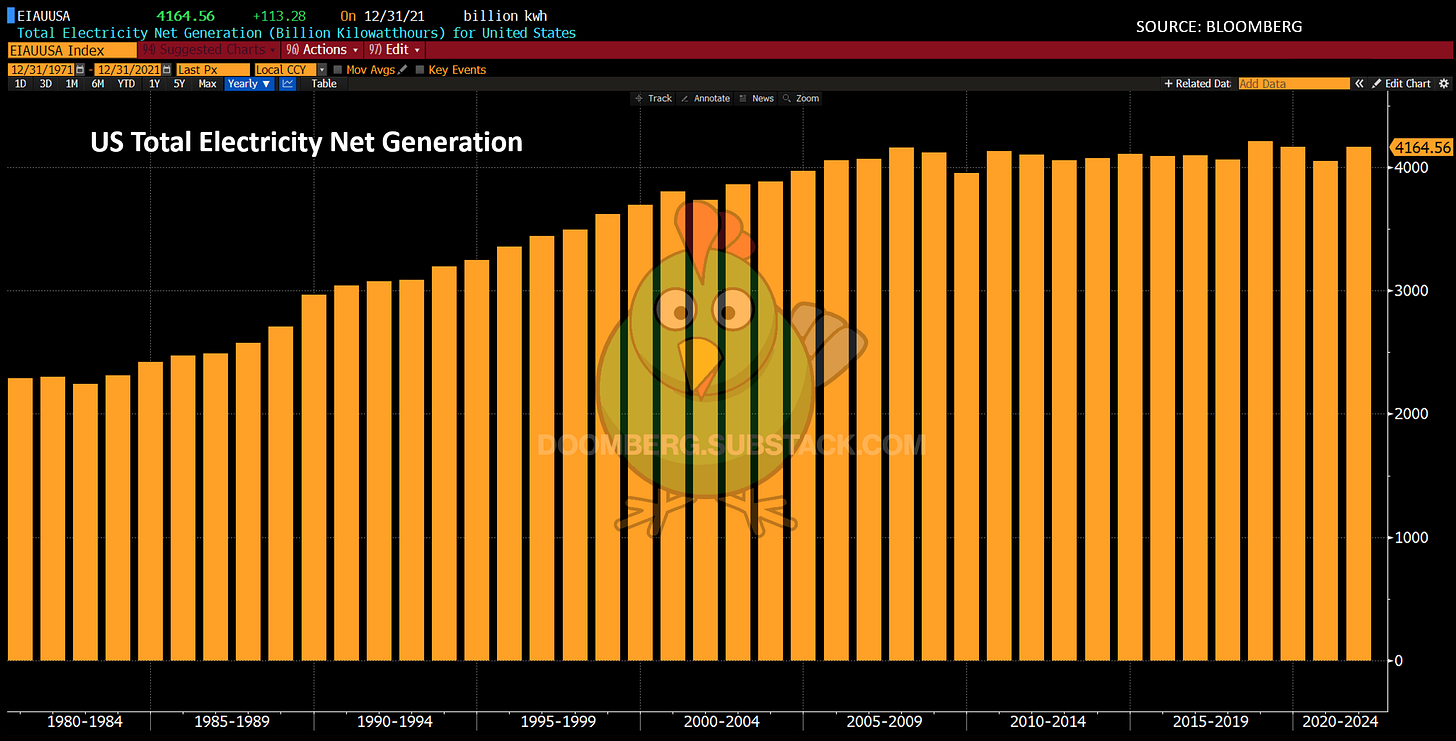Prime Time
As Amazon enters the nuclear chat, it’s time to get technical about uranium enrichment.
“I've always been at the intersection of computers and whatever they can revolutionize.” – Jeff Bezos
Last week, J.P. Morgan’s Michael Cembalest published the 14th edition of his popular annual energy letter. In this year’s essay, Electravision, Cembalest performed a deep dive into the potential to electrify everything. Achieving this vision of the climate change movement requires a literal rewiring of how society generates and transmits energy, a challenge Cembalest is careful to quantify using facts and data. One glaring constraint is the seeming inability of the US to materially grow electricity generation, a metric that has been essentially flat for decades:
Given the ongoing bubble in artificial intelligence (AI) stocks, the market looks set to force the issue quite soon. The avalanche of money pouring into the AI sector will inevitably create a wave of fresh demand for power, something Cembalest noted in his essay (emphasis added throughout):
“An important caveat: our Electravision scenario assumes that total US energy needs will not change much over the next two decades. Unchanged US energy demand is consistent with the last couple of decades; the energy needs of a growing US population have been offset by improving energy efficiency. However, the rise of AI might change that. One illustrative example: the PJM (mid-Atlantic) region has made sharp increases to projections of future power demand.
These increases are entirely due to an increase in data centers which serve advanced computing/AI needs. Constellation Energy estimates that the AI revolution could require more power in the US than the future electric vehicle fleet. If that’s the case, the productivity benefits from AI better be large enough to offset the increase power load. Bottom line: the rise of AI could make the journey to Electravision longer, harder and most costly.”
In Fission Chips, a piece published last November, we speculated that the need to power AI might be the issue that fuels a nuclear renaissance. Society has always rearranged itself to grow its computing power exponentially, and nuclear is the obvious (and, for all practical purposes, the only) answer to keeping us on that path. We concluded that “[t]he advance of AI, for better or worse, may be the force that finally lifts nuclear from the fallacy of its bad reputation in the US. Kurzweil’s vision requires vastly more nuclear power to be realized, and betting against The Singularity has been a losing trade for decades.”
Pro-nuclear advocates welcomed an historic announcement last week when Amazon Web Services (AWS), the world’s largest operator of data centers, made a decisive move that all but validated the inevitable:
“One of the US’s largest nuclear power plants will directly power cloud service provider Amazon Web Services’ new data center. Power provider Talen Energy sold its data center campus, Cumulus Data Assets, to Amazon Web Services for $650 million. Amazon will develop an up to 960-megawatt (MW) data center at the Salem Township site in Luzerne County, Pennsylvania.
The 1,200-acre campus is directly powered by an adjacent 2.5 gigawatt (GW) nuclear power station also owned by Talen Energy.
The 1,075-acre Susquehanna Steam Electric Station is the sixth-largest nuclear power plant in the US. It’s been online since 1983 and produces 63 million kilowatt hours per day. The plant has two General Electric boiling water reactors within a Mark II containment building that are licensed through 2042 and 2044.”
The AWS news comes on the heels of other notable developments pointing to a logical reunification of physics and policy. The global stocktake from the most recent United Nations climate change summit acknowledged, for the first time, that nuclear is an essential and clean contributor to decarbonization efforts. At the same meeting, the Biden administration led a coalition of more than 20 countries that collectively committed to tripling their nuclear capacity by 2050. A wave of nuclear reactors is under construction in China and India, while Japan is busy restarting much of its mothballed capacity. Having observed what happened in Germany after its insane decision to exit nuclear, practically every other country of influence is responding accordingly. It is only a matter of time before Germany course corrects.
The speed of the nuclear pivot has some wondering whether the uranium fuel supply chain can keep up with anticipated demand. In last month’s Doom Zoom webinar available to Pro tier subscribers, physicist James Krellenstein of Alva Energy delivered a 90-minute presentation titled “From Ore to Core: Understanding the Front End of the Nuclear Fuel Cycle.” What is the state of readily mined uranium supply? What are the geopolitical forces impacting the conversion and enrichment of the stuff? Let’s connect some of the dots from Krellenstein’s excellent work.



